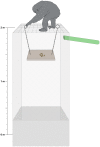Problem solving in the presence of others: how rank and relationship quality impact resource acquisition in chimpanzees (Pan troglodytes)
- PMID: 24695486
- PMCID: PMC3973697
- DOI: 10.1371/journal.pone.0093204
Problem solving in the presence of others: how rank and relationship quality impact resource acquisition in chimpanzees (Pan troglodytes)
Abstract
In the wild, chimpanzees (Pan troglodytes) are often faced with clumped food resources that they may know how to access but abstain from doing so due to social pressures. To better understand how social settings influence resource acquisition, we tested fifteen semi-wild chimpanzees from two social groups alone and in the presence of others. We investigated how resource acquisition was affected by relative social dominance, whether collaborative problem solving or (active or passive) sharing occurred amongst any of the dyads, and whether these outcomes were related to relationship quality as determined from six months of observational data. Results indicated that chimpanzees obtained fewer rewards when tested in the presence of others compared to when they were tested alone, and this loss tended to be greater when paired with a higher ranked individual. Individuals demonstrated behavioral inhibition; chimpanzees who showed proficient skill when alone often abstained from solving the task when in the presence of others. Finally, individuals with close social relationships spent more time together in the problem solving space, but collaboration and sharing were infrequent and sessions in which collaboration or sharing did occur contained more instances of aggression. Group living provides benefits and imposes costs, and these findings highlight that one cost of group living may be diminishing productive individual behaviors.
Conflict of interest statement
Figures



References
-
- van Schaik CP (1983) Why are diurnal primates living in groups? Behaviour 87: 120–144.
-
- Coussi-Korbel S, Fragaszy DM (1995) On the relation between social dynamics and social learning. Animal Behaviour 50: 1441–1453.
-
- West-Eberhard MJ (1979) Sexual selection, social competition, and evolution. Proceedings of the American Philosophical Society 123: 222–234.
-
- Yamakoshi G, Sugiyama Y (1995) Pestle-pounding behavior of wild chimpanzees at Bossou, Guinea: a newly observed tool-using behavior. Primates 36: 489–500.
-
- Humle T, Matsuzawa T (2004) Oil palm use by adjacent communities of chimpanzees at Bossou and Nimba Mountains, West Africa. International Journal of Primatology 25: 551–581.
Publication types
MeSH terms
LinkOut - more resources
Full Text Sources
Other Literature Sources

